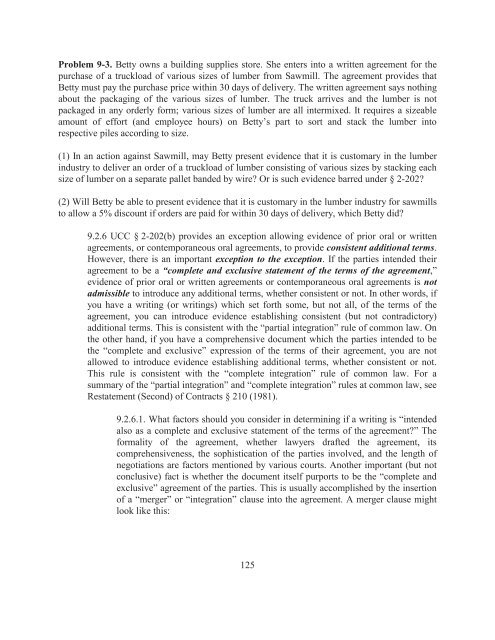Sales and Leases - A Problem-based Approach, 2016a
Sales and Leases - A Problem-based Approach, 2016a
Sales and Leases - A Problem-based Approach, 2016a
Create successful ePaper yourself
Turn your PDF publications into a flip-book with our unique Google optimized e-Paper software.
<strong>Problem</strong> 9-3. Betty owns a building supplies store. She enters into a written agreement for the<br />
purchase of a truckload of various sizes of lumber from Sawmill. The agreement provides that<br />
Betty must pay the purchase price within 30 days of delivery. The written agreement says nothing<br />
about the packaging of the various sizes of lumber. The truck arrives <strong>and</strong> the lumber is not<br />
packaged in any orderly form; various sizes of lumber are all intermixed. It requires a sizeable<br />
amount of effort (<strong>and</strong> employee hours) on Betty’s part to sort <strong>and</strong> stack the lumber into<br />
respective piles according to size.<br />
(1) In an action against Sawmill, may Betty present evidence that it is customary in the lumber<br />
industry to deliver an order of a truckload of lumber consisting of various sizes by stacking each<br />
size of lumber on a separate pallet b<strong>and</strong>ed by wire? Or is such evidence barred under § 2-202?<br />
(2) Will Betty be able to present evidence that it is customary in the lumber industry for sawmills<br />
to allow a 5% discount if orders are paid for within 30 days of delivery, which Betty did?<br />
9.2.6 UCC § 2-202(b) provides an exception allowing evidence of prior oral or written<br />
agreements, or contemporaneous oral agreements, to provide consistent additional terms.<br />
However, there is an important exception to the exception. If the parties intended their<br />
agreement to be a “complete <strong>and</strong> exclusive statement of the terms of the agreement,”<br />
evidence of prior oral or written agreements or contemporaneous oral agreements is not<br />
admissible to introduce any additional terms, whether consistent or not. In other words, if<br />
you have a writing (or writings) which set forth some, but not all, of the terms of the<br />
agreement, you can introduce evidence establishing consistent (but not contradictory)<br />
additional terms. This is consistent with the “partial integration” rule of common law. On<br />
the other h<strong>and</strong>, if you have a comprehensive document which the parties intended to be<br />
the “complete <strong>and</strong> exclusive” expression of the terms of their agreement, you are not<br />
allowed to introduce evidence establishing additional terms, whether consistent or not.<br />
This rule is consistent with the “complete integration” rule of common law. For a<br />
summary of the “partial integration” <strong>and</strong> “complete integration” rules at common law, see<br />
Restatement (Second) of Contracts § 210 (1981).<br />
9.2.6.1. What factors should you consider in determining if a writing is “intended<br />
also as a complete <strong>and</strong> exclusive statement of the terms of the agreement?” The<br />
formality of the agreement, whether lawyers drafted the agreement, its<br />
comprehensiveness, the sophistication of the parties involved, <strong>and</strong> the length of<br />
negotiations are factors mentioned by various courts. Another important (but not<br />
conclusive) fact is whether the document itself purports to be the “complete <strong>and</strong><br />
exclusive” agreement of the parties. This is usually accomplished by the insertion<br />
of a “merger” or “integration” clause into the agreement. A merger clause might<br />
look like this:<br />
125


















